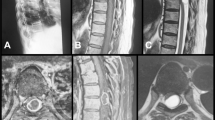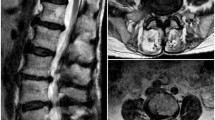Abstract
Introduction
Cervical prolapsed intervertebral disc is one of the common conditions causing cervical myeloradiculopathy. Anterior Cervical Discectomy and Fusion (ACDF) is the standard line of management for the same. Intradural neurogenic origin tumors are relatively rare and can present with features of myeloradiculopathy. Radiological imaging plays important role in diagnosis of such pathologies.
Case report
We report a patient with C5-6 cervical disc prolapse that presented with radiculopathy symptoms in the right upper limb, which was refractory to conservative care. He underwent a C5-6 ACDF and reported complete relief from symptoms at 4 weeks. He developed deteriorating symptoms over the next 10 weeks and presented at 14 weeks follow-up with severe myeloradiculopathy symptoms on the left upper limb with upper limb weakness. A fresh MRI identified an intradural extramedullary tumor with cystic changes at the index surgery level. This was treated with tumor excision and histopathology confirmed a diagnosis of schwannoma. Simultaneous presence of cord signal changes with disc herniation obscured the cystic schwannoma which became apparent later on contrast enhanced MRI imaging.
Conclusion
Careful review of preoperative imaging and contrast MRI study may help in diagnosing cystic schwannomas with concomitant cervical disc herniations that have cord signal changes.
This is a preview of subscription content, access via your institution
Access options
Subscribe to this journal
Receive 1 print issues and online access
We are sorry, but there is no personal subscription option available for your country.
Buy this article
- Purchase on Springer Link
- Instant access to full article PDF
Prices may be subject to local taxes which are calculated during checkout




Similar content being viewed by others
Data availability
Data is not a part of a public repository.
References
Abbed KM, Coumans JVCE. Cervical radiculopathy: pathophysiology, presentation, and clinical evaluation. Neurosurgery. 2007;60:S1–28.
Bapat MR, Rathi P, Pawar U, Chaudhary K. Intradural tumor and concomitant disc herniation of cervical spine. Indian J Orthop. 2011;45:74–7.
Vitzthum HE, Dalitz K. Analysis of five specific scores for cervical spondylogenic myelopathy. Eur Spine J. 2007;16:2096–103.
Lin CM. Cervical spine intradural-extramedullary hematoma presenting as ipsilateral hemiparesis. Neurol Int. 2011;3:8.
Van Goethem JWM, van den Hauwe L, Özsarlak Ö, De Schepper AMA, Parizel PM. Spinal tumors. Eur J Radio. 2004;50:159–76.
Lee M, Epstein FJ, Rezai AR, Zagzag D. Nonneoplastic intramedullary spinal cord lesions mimicking tumors. Neurosurgery. 1998;43:788–94.
Bashir S, Memon AA, Sanaullah M, Hasan Y. Intra-medullary tuberculoma of the spinal cord presenting with typhoid and paraplegia: a case report. J Med Case Rep. 2012;6:388.
Givan G, Simons SM, Yount R. Cervical schwannoma presenting as neck pain following motor vehicle accident. Curr Sports Med Rep. 2011;10:37–9.
Asazuma T, Toyama Y, Watanabe M, Suzuki N, Fujimura Y, Hirabayashi K. Clinical features associated with recurrence of tumours of the spinal cord and cauda equina. Spinal Cord. 2003;41:85–9.
Author information
Authors and Affiliations
Contributions
SRH: conceptualization, methodology, supervision, project administration; NVS and SM: data curation, writing draft, visualization; SNA: modification of primary draft, investigation, review and editing, project administration; PKS: project management. All authors read and approved the final manuscript.
Corresponding author
Ethics declarations
Competing interests
The authors declare no competing interests.
Consent to participate
Informed consent was obtained from all individual participants included in the study.
Consent to publish
The authors affirm that human research participants provided informed consent for publication of the images in Figs. 1–4.
Additional information
Publisher’s note Springer Nature remains neutral with regard to jurisdictional claims in published maps and institutional affiliations.
Supplementary information
Rights and permissions
Springer Nature or its licensor (e.g. a society or other partner) holds exclusive rights to this article under a publishing agreement with the author(s) or other rightsholder(s); author self-archiving of the accepted manuscript version of this article is solely governed by the terms of such publishing agreement and applicable law.
About this article
Cite this article
Hadgaonkar, S.R., Situt, N.V., Marya, S. et al. Cervical Schwannoma camouflaged by cervical intervertebral disc prolapse—A case report. Spinal Cord Ser Cases 9, 52 (2023). https://doi.org/10.1038/s41394-023-00609-y
Received:
Revised:
Accepted:
Published:
DOI: https://doi.org/10.1038/s41394-023-00609-y



